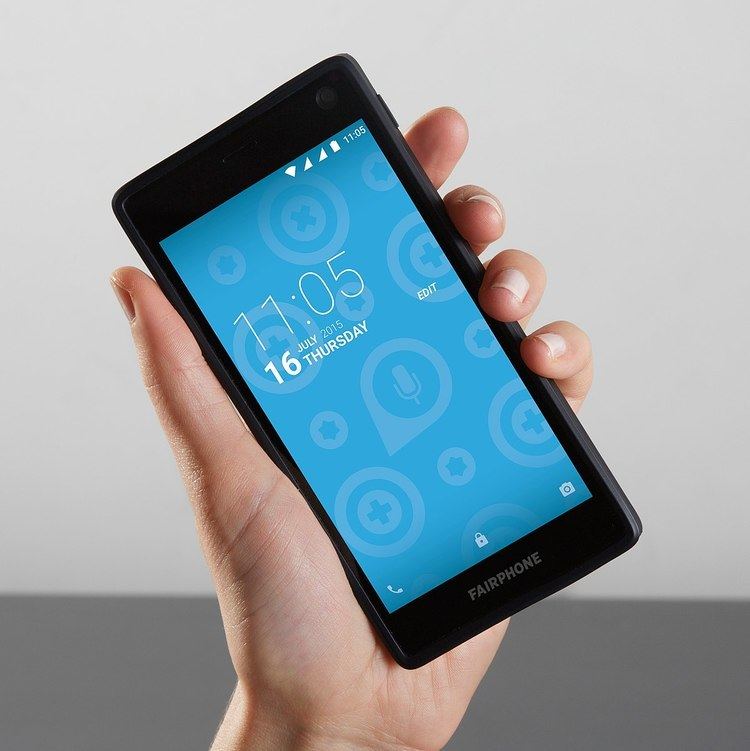Form factor slate | Manufacturer Hi-P | |
 | ||
Units shipped 40,000 (as of May 26, 2016) | ||
The Fairphone 2 is a touchscreen-based, dual-SIM smartphone first released in December 2015. It is the first modular smartphone to be available for purchase and is designed to be easily repaired by the user. The phone runs Android 5.1. It is the second phone from the social enterprise Fairphone and the first one completely designed by them. The phone is ethically sourced, using conflict-free minerals, Fairtrade gold and recycled materials, and is assembled in audited factories with good working conditions.
Contents
Hardware choice
The phone is designed to have a higher life expectancy (5 years) than other phones.
The main problem on the Fairphone 1 was a SoC (Mediatek MT6589) that wasn't widely used and thus didn't receive long-term software support from its manufacturer. For the Fairphone 2 the choice settled on the widely used Snapdragon 801 platform (a high-end, early 2014 platform); the popularity of this SoC should help maintain the Fairphone 2 for a long time.
Fairphone deliberately didn't include some recent innovations like wireless charging or USB Type-C port, ensuring a lower price and fewer compatibility issues, but the modular design of the phone will allow Fairphone team to develop newer modules with updated components in the future (most probable component upgrades are USB Type-C port and better camera).
Also, the Fairphone 2 back is equipped with a USB pin-out and charging input, allowing aftermarket back covers with extended capabilities.
Ethical considerations
The phone is designed to have a lower environmental impact than comparable mass-market smartphones, with an expected lifespan of 5 years. The modular design allows individual components to be replaced without having to replace the entire phone.
Many electronic devices contain conflict minerals – tin, tungsten, tantalum and gold from the Democratic Republic of the Congo (DRC), used by armies and rebel groups to fund war in the country. Some manufacturers therefore avoid all materials from the DRC, but this reduces employment opportunities in the country. The Fairphone 2 supply chain is audited to ensure that these materials come from mines that do not fund armed groups, while supporting local communities in the DRC where possible in order to provide an alternative to conflict mines. The tantalum and tin ore is sourced from conflict-free mines in the DRC, the tungsten from Rwanda, and the gold from a Fairtrade-certified mine in Peru. In addition, the phone includes recycled plastic, copper and tungsten.
The Fairphone 2 is assembled by Hi-P in Suzhou, China, in a factory which has been audited to ensure that it meets high standards for working conditions and the environment.
Modular design
The phone is the first modular smartphone available to the general public. The modular, repairable design to increase longevity and through a focus on increasing the recyclability of the product. The phone components are designed to be replaceable using only a screwdriver by the end user, in addition it is possible to replace individual components within each module. The phone received the highest ever score for a smartphone for repairability (10/10) from iFixit. The phone consists of 7 removable parts; the main chassis, the removable battery, the display assembly, rear camera module, receiver module, the speaker module and back protective cover. With the exception of an updated slim case design, the first module set to be upgraded will be the camera, with a more powerful replacement to be released in 2017.
Software
The Fairphone 2 launched with Android 5.1. Two variants of Android are available – the default Android installation which includes Google mobile services (GMS), and the Fairphone Open Source OS which does not include GMS but can be easily rooted. Unlike most Android manufacturers, Fairphone is committed to regularly releasing security patches and other updates. An upgrade to Android 6 is planned, and will be free for all customers. A port of the alternative Sailfish OS is also underway, with input from Fairphone developers.
Costs
The phone was primarily funded through pre-orders and is mostly being sold directly, though in some markets the phone is available through resellers such as The Phone Co-op in the UK. The pre-order campaign started on July 16, 2015 and ended on September 30, with 17,418 phones pre-ordered (the objective was 15,000).
As for the Fairphone 1, the company released the detail of the costs. Despite its relatively high-price (a similarly equipped "normal" phone cost about 250 to 300 USD) the margin on each phone sold is only €9, principally due to low sales volume and higher manufacturing costs. The price also include a wide range of initiative launched by Fairphone to make the phone more ethical, including recycling programs and partnerships for less "blood minerals" usage
Sales
On July 16, 2015, pre-orders for Fairphone 2 were opened. To order the components to assemble the first devices and to generate the revenue needed to ensure continuous production, Fairphone initiated a crowdfunding campaign by setting the goal to achieve 15,000 pre-orders by the end of September. The goal was finally exceeded, reaching a total of 17,418 pre-orders until September 30. Production started in December 2015, with the aim of shipping all phones ordered during the crowdfunding campaign during that month. However, issues in ramping up production caused a delay. The last pre-ordered device was shipped on February 8, 2016. On May 26, 2016, Fairphone reported that the milestone of 40,000 Fairphone 2 sold has been reached and all phones ordered until this date have been shipped. The device would henceforth be in stock.
